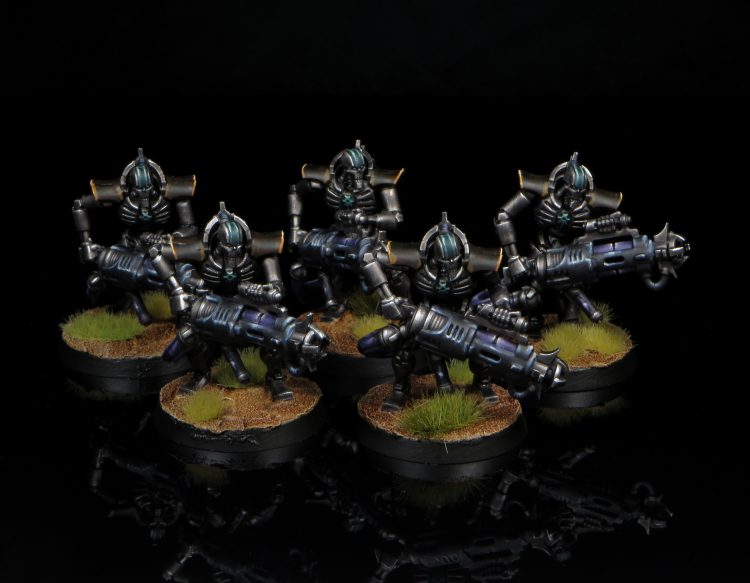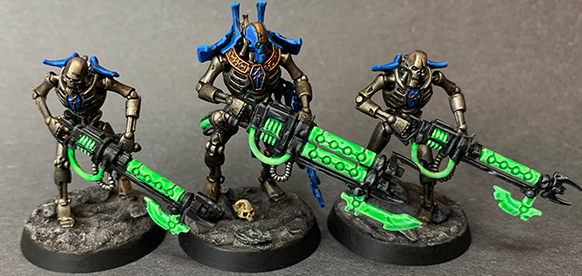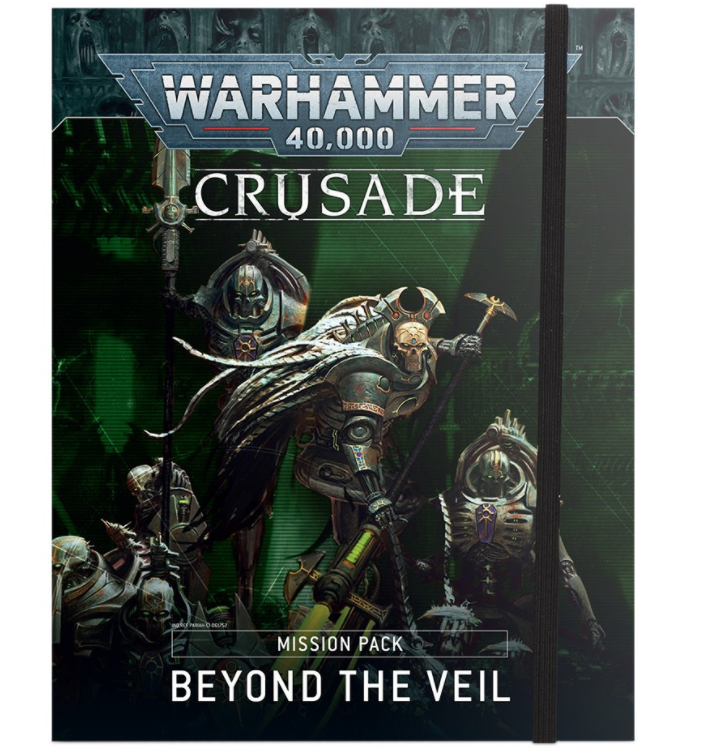While the majority of our articles focus on competitive and tournament play for Warhammer 40,000, many of us here at Goonhammer enjoy narrative games that drip with theme and story as much as we do matched play games – some of us even prefer it. Unfortunately, the rules for narrative games in eighth edition left much to be desired. So when Games Workshop announced the new Crusade rules in the ninth edition rules, we were champing at the bit to give it a shot.
Thankfully, the Crusade rules don’t disappoint – they provide a flexible framework that you can use to string together a narrative between your various games. However, they do have a few weak spots – there are only a handful of missions on offer at each points level (only 3 each at Combat Patrol and Onslaught, and 6 each at Incursion and Strike Force), and the options for unit upgrades, roster upgrades, and battle scars, while interesting, are limited and can be somewhat underwhelming. That’s to be expected, though – not only do these rules need to provide options that will work for each of the different armies that can be found in the 41st millennium, they also need to support campaigns set wherever you and your friends want to play, which opens up as many possibilities as it closes. We know that’s changing, though – in recent Warhammer Community articles, GW has shown us some of the Crusade options that’ll be coming in future Codexes, such as interring a mortally wounded Captain in a Dreadnought so his service can extend even beyond his death, or pushing a Destroyer into a berserk rage, making them stronger but more difficult to control as they gradually lose their sense of self.
Recently, Games Workshop announced another way to expand the Crusade options beyond just adding new options to the various factions: Campaign books reminiscent of the Vigilus and Psychic Awakening series. These are perfect opportunities to provide new missions, customization options, and agendas for you to incorporate in your campaigns. The first of these, Crusade: Beyond the Veil, releases on October 3, and contains everything you and your friends will need to wage war in the Pariah Nexus, a region of Ultima Segmentum that is shrouded in mystery and which is completely cut off from communication with the wider galaxy. Games Workshop were kind enough to send us an advance copy, and we immediately dove in – how do the new missions and rules stack up? Do they capture the mystery of the Pariah Nexus (one of the only cool parts of Psychic Awakening: Pariah)? Are the new Crusade relics and traits worth your time?
Let’s find out.
What’s in the Book?
Like the Grand Tournament Pack and the Tactical Deployment book, Beyond the Veil is a spiral-bound book that contains all the rules you need to get started with your chosen game type. This includes new missions and Crusade upgrades, as well as reprints of the core rules you’ll need to play these games, a few pages of story to set the scene, and an entirely new mechanic called Investigation Points, which represents your army’s ongoing effort to figure out just what in the hell is even happening here.
First up in the book is a short introduction to War Zone Pariah, setting the scene and laying out the stakes. Unfortunately, it’s pretty thin – only 4 pages, including a full-page map and some nice art – and will leave you with more questions than you had going in. However, it does a good job of setting the mood in the small space it’s working with.

Preparing for War in the Pariah Nexus
After that, it’s right into how to play Crusade games in the Pariah Nexus. Most of the process here is the same, but there are plenty of new options to work with. One of the first things you’ll notice is an entirely new step added to the pre-game sequence: Theater of War effects. These include Strategic Setbacks and Afflictions, which are determined after the mission is chosen but before players muster their armies. These are, for the most part, randomly determined – one of each, from a list of three setbacks and 6 potential afflictions. Strategic Setbacks tend to affect how armies deploy and arrive from reserves, with effects that may delay your reserves or force you to split your army during deployment. Afflictions on the other hand tend to affect your units’ characteristics, reducing their effectiveness in battle. The Beyond the Veil rules recommend one of each per game but also suggest that the Afflictions rules are optional and subject to players agreeing to use them. This is fair as they tend to be much more unbalancing and can be devastating – one of them forces both players to subtract 1 from all advance and charge rolls and the strength of all their units, while another worsens all invulnerable saves by 1 – but the Strategic Setbacks shake up deployment and pose new problems for you to grapple with right from the outset of the game, whether it’s delayed reinforcements, or a staggered deployment that sees your force deploying over the course of the first 3 rounds.
Beyond the Veil also presents 7 more agendas to choose from for each game, adding at least one to each category. The first three on offer are fairly straightforward, if somewhat niche. You won’t want them in every game, but under the right circumstances they could be worthwhile. Ambush gives experience points to units who deploy from reserves or reinforcements and kill enemies, with double credit for wrecking something the turn they show up on the board. Extermination Order gives 2XP to any unit that destroys at least one enemy unit in 3 or more battle rounds. Marshal Forces has you adding to a tally for each time one of your units is within 3″ of a friendly CHARACTER that’s within 3″ of the center of the board, and grants 1XP for every 3 marks on that tally. (Condit Note: It’s an open question whether a unit gains 2 tallies if it’s next to 2 separate characters, but given that the rules seem to assume you could get more than 1XP, I think it probably does.)
More interesting are the Shadow Operations and Warpcraft Agendas. Each category brings two new Action-based Agendas that your units can attempt. Uncover the Answers lets a unit “uncover” an objective marker to gain 1XP. Make Contact sees you nominating an objective as a communications terminal, then holding it and repeatedly taking actions to reach out to others in your chain of command. Through the Stillness requires Psychic Actions at each of the board edges, offering 1XP for each edge that you “pierce.” Finally, Psychic Beacon sees your Psykers gathering in the middle of the battlefield to send a signal to your allies through the warp.
The experience isn’t everything here, though – if your army is able to complete these Agendas enough times over the course of the game, you’ll gain Investigation Points as well, which represent your force’s ongoing attempts to determine what’s causing the unexplained phenomena in the Pariah Nexus. Investigation Points are essentially a second currency for Crusade forces and can be spent on a variety effects, from clearing Battle Scars to adding Battle Honors, though the cost is usually pretty high – gaining a requisition point clocks in at 4 IP, so this won’t ramp up your list that much faster, but it does provide a nice bonus if you lean into the narrative conceit of investigating the mysteries of this strange place.

Battlefields of the Stillworlds
The majority of the book is a set of six narrative missions for each game level – yes, even for Combat Patrol and Onslaught – each of which is based around modeling an army’s progress through the Pariah Nexus, attempting to discern what’s going on and tell the story of an army gradually discovering the secret and becoming embroiled in conflict as they fight their way out. Many of these missions are asymmetrical and narratively they’re designed to model the Imperium’s campaign into the sector as they come under attack from Necron forces. If you really wanted to dive into the lore of Indomitus, doing this as an escalation campaign with Necron and Imperium armies seems like an incredibly cool way to do this. That said, the missions and the rules here work very well for any faction, and provide lots of room for different interpretations, whether it be a rival Necron dynasty investigating the Silent King’s plans and looking for weak spots, Orks spoiling for a fight in a part of the galaxy where no one’s heart seems into it, or Tyranids attempting to put an end to a phenomena that is muting the Hive Mind’s control.
The missions are otherwise pretty cool and take a lot more creative liberty than the ones in the Core Rulebook, leaning into the investigative aspects of the BTV campaign with the smaller missions and creating some cool all-out-war scenarios with the larger missions. Some particular favorites of ours:
- Lying in Wait (Combat Patrol) presents a much less lopsided Ambush scenario than what we saw in 8th edition, where the Attacker splits their forces and is tasked with destroying three mission critical assets held by the Defender.
- The Stilled (Incursion) sees armies doing battle over a battlefield populated with the Stilled – listless, aimless people who have seemingly lost all sense. The mission has players attempting to capture and escort these Stilled for study, though the objectives themselves will wander around aimlessly each battle round.
- Fighting Retreat (Strike Force) sees one army falling back as it fights off attackers, with 5 objective markers worth progressively more points to the Attacker each battle round if they can continue pressing forward and forcing the Defender backward.
- Abandoned City (Strike Force) has armies stalking through a long-abandoned city, investigating buildings as they go (and scoring VP for doing so).
- The Shield (Onslaught) is a bigger version of The Shroud (Incursion) and puts an invisible shield line across the middle of the table; firing across that line ensures the target will get a 5+ invulnerable save. This creates an interesting tug-of-war where armies will want to push beyond the shield line in order to increase their effectiveness, but in doing so will make themselves vulnerable.

Marching Onwards
Once you’ve played a mission, completed some Agendas, and racked up some experience, Beyond the Veil offers a set of new Battle Honors you can apply to your units. This includes new traits, a set of Relics of the Crusade, and even some new battle scars that are a bit more interesting than the ones in the core rules.
This supplement adds 6 new battle traits for your units to choose from, 3 for any unit other than vehicles and monsters, and 1 each for vehicles, monsters and characters. Most of them have at least some use, whether that’s an aura that allows nearby models to use a character’s leadership instead of their own, or the ability to re-roll 1s and 2s on advance and charge rolls. Unfortunately, the trait for vehicles falls a bit flat – since most damage in the Psychic phase comes through mortal wounds, it will usually overlap with Blessed Hull from the core rules. However, if you regularly find yourself playing against Grey Knights or some other faction that makes attacks during the Psychic phase, you might find some use for it. All in all, these provide some interesting options, but nothing really game-breaking.
The new Relics of the Nexus work similarly to the Crusade Relics in the core rules, with the restriction that you can only take one if your character was in a battle set in the Pariah Nexus. There are 4 new relics on offer here, and each of them brings something new to the table. However, when you give a Relic of the Nexus to a model, it’s still an object of deep mystery, with unknown functions that will need to be discovered in order to unlock the object’s true power. The way you do this is straightforward: roll a d6 after each mission, and on a 6+, you “unlock” a more powerful effect for that relic. For instance, the Solar Shift Core allows your unit to make “short phasing jumps,” which translates in game terms into allowing you to re-roll advance and charge rolls for it. However, once it’s unlocked, it adds an additional effect that prevents targets of that unit’s charges from firing Overwatch or using the Set to Defend reaction.
The Relics of the Nexus are pretty heavily Necron-themed, with names like “Blackstone Ankh,” “Hieroptek Staff,” and “Rod of Lambent Energy.” In keeping with this theme, Necrons get a +4 to the roll to unlock each relic’s additional ability. However, that’s not the only way you can improve your roll: other factions can spend Investigation Points on a 1-for-1 basis to add a bonus to their roll, which plays into the themes of mystery and investigation. This is also one of the few areas where the book gives the Necrons a leg up in their “investigation” of the Pariah Nexus: that +4 saves them 4IP, and makes the Relics of the Nexus more attractive upgrades since you’re a lot more likely to get the full effect out of the gate.
Finally, this book includes a set of new battle scars you can assign to a unit should they fail an out-of-action roll – 1 each for Psykers, Characters, Vehicles, and Monsters, and 3 for everything else. Unlike the ones in the core rules, though, these aren’t all downside. Instead, each of the battle scars here involves a tradeoff: Suffocating Madness sees a Psyker rolling 3d6 and discarding the highest whenever it makes a psychic test, but also lets them re-roll wound rolls in melee. Unnerved will simulate a unit being constantly on edge, forcing them to roll 6s on any Morale test, but also letting them move up to d6″ if an enemy sets up as reinforcements within 12″ of them. Rather than imposing an unqualified penalty, these battle scars create tradeoffs that you might not want to trade away immediately. And while they won’t lower the unit’s crusade points like the options in the core rules, they do create the opportunity for some compelling narrative hooks that just weren’t available before.

What’s Not in the Book
Perhaps the weirdest omission from Beyond the Veil is that it doesn’t include any of the original Crusade rules from the 9th edition Core Rulebook. While having the core rules reprinted here is convenient, it’s not nearly as convenient as reproducing the Crusade rules, which you’re still likely to need for games taking place in the Pariah Nexus as they haven’t reproduced any of the standard Agendas, Battle Scars, or rules for spending Requisition Points here. The cynic in me would suggest that this is because doing so would mean you’d no longer need to buy the core rulebook for 9th edition, but the realist in me scoffs at that and just wants GW to release a spiral-bound Crusade rules handbook so I can pay even more money to not have to cart around a book I already paid for.
Something else to note is that while the new currency, Investigation Points, is a cool addition that’s very thematic within the context of the Pariah Nexus, it’s also something that we hope to see used sparingly. Part of this is to avoid dulling its impact – investigation won’t always be the focus – and part of it is so Crusade armies don’t end up racking up a bunch of leftover points they can’t use from half a dozen different campaigns with Investigation/Loyalty/Favor of the Dark Gods/Whatever points that are only usable in one campaign setting.
Finally, it’s a bit strange that Necrons don’t have some kind of custom rules here beyond the relic activations, but we expect we’ll be seeing a ton of new Crusade content from them when their Codex drops in a few weeks anyways, and this is a minor gripe.
Final Verdict:
On the whole, Beyond the Veil does a lot of things right, adds a ton of great options, really captures the feel of the Pariah Nexus and leaves us wanting more. It feels like a “must-have” for anyone starting up a Crusade with friends, adding a ton of additional missions and color to the core rules in a way that makes us excited for future Crusade supplements. We weren’t massive fans of the idea of going back to the start of the Indomitus Crusade with 9th edition’s lore, but on the other hand, it gives us a ton of additional warzones to explore and if it means that we could potentially get Crusade packs for Konor or Vigilus at some point in the future, then it’ll be a benefit. If you’re doing Crusade, it’s worth your time to pick up Beyond the Veil.


